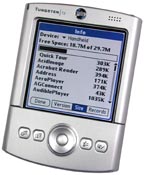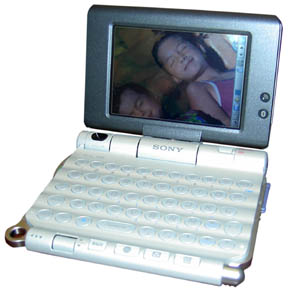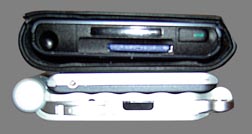July 2003
SD WiFi card from SanDisk nears shipping
SanDisk's WiFi card will begin appearing in stores this August. The long awaited card uses technology from SyChip touted at CES earlier this year. See the review by Steve Bush at Brighthand.com. -- Posted Friday, July 25, 2003 by sab
Tungsten T2 features better screen, more RAM
 Palm's Tungsten T series gets an upgrade today with more RAM, the latest OS, and a brighter screen. We've done a little comparing, and while the screen is vibrant and beautiful, there's still one place that the original T still shines. See the review. -- Posted Wednesday, July 23, 2003 by sab
Palm's Tungsten T series gets an upgrade today with more RAM, the latest OS, and a brighter screen. We've done a little comparing, and while the screen is vibrant and beautiful, there's still one place that the original T still shines. See the review. -- Posted Wednesday, July 23, 2003 by sab
Handspring sales plunge, loss narrows
Handspring said its 4th quarter loss narrowed from US$15.4 million to US$13 million. Revenues dramatically collapsed from US$49 million to US$14.5 million. -- Posted Tuesday, July 22, 2003 by chb
New CLIE with larger keyboard, landscape screen, wireless
 Preview: Sony's CLIE UX50, announced by the company today, is nothing short of a marvel. It's both the return of the HPC and the morphing of the Palm into something more powerful and functional while retaining the small size. For Sony it marks the entry of a new processor, specially made for the new communicator line.
Preview: Sony's CLIE UX50, announced by the company today, is nothing short of a marvel. It's both the return of the HPC and the morphing of the Palm into something more powerful and functional while retaining the small size. For Sony it marks the entry of a new processor, specially made for the new communicator line.
It borrows a lot of features from the NX and NZ product, with its flip and rotate screen, built-in keyboard, and 320 x 480 screen, but once again the world has been set on its side, with portrait orientation being dumped for landscape--far more logical for Web browsing and email composition. Also from the rotation comes a larger keyboard. The device comes in at about the same size as a Palm Tungsten T in a case, though a little wider (see photo--apologies for the bad focus); otherwise it's about as tall and thick. It weighs 6.2 ounces.
The new product features a breakthrough processor design, made by Sony in the same fab that makes the PlayStation 2 processors. They're calling it the Handheld Engine (CXD2230GA). At its core is an ARM926, optimized to step its power usage depending on system demand, stepping way down to display an organizer screen, while ramping up for MP3 and Video, via what Sony calls Dynamic Voltage and Frequency Management. Its five hour expected video performance--at 30 frames per second--enables one to watch two full length movies on the device with the snap-on extended battery. The new chip also integrates a 2D graphics engine, digital camera, and nearly all of the I/O controls into a single chip, making the UX50's small size and impressive power possible.
Also built into the new device is Automatic Data Protection. When the battery drains to a certain level, all data is copied from the volatile 16MB RAM to a non-Volatile 16MB set aside for the purpose. In addition to the 16MB RAM there are 29MB of non-volatile RAM set aside for loading user data, like videos, databases, and MP3 files. All one will need do in case the battery runs down is recharge and all the data should be safe, something PDA users have been waiting for.

The unit contains the rest of usual stuff we've come to expect from the twist and flip line, including MP3, and a digital camera for stills and video on the hinge--in this case a VGA camera (300K pixels). It also includes something no other device has: both Bluetooth and 802.11b built in. So you can use WiFi in the office and at Starbucks, and your cell phone while away from these hot spots. Ideal. What we've all been waiting for.
One of the obvious questions many will ask is whether the screen rotates to portrait mode; it does not. Instead, the Graffiti 2 area is stacked and off to the left or right, with the number entry area on top of the letter area.
The keyboard is waved, not unlike a drive in theater parking lot, allowing easier access to the keys. They've also included a number row across the top, something lacking on past Sony keyboards.
Across the front of the unit are a wheel for scrolling or pressing in to activate, and four buttons, for back, Web, email, and find. The stylus is accessed below on the right, and capture is under the screen. A cradle will be included, which is little more than a snap-on plastic base that only charges. A separate cable is included for HotSyncing, which attaches at left next to the power switch. Perhaps Sony is expecting a lot of users to wirelessly hot sync with either Bluetooth or 802.11b, which are built into more and more PCs.
New software features include quick access to files by tapping on the Memory Stick icon, which launches the file manager, and quick status check of the battery, also by tapping on the icon. The reset button is easily activated by the stylus tip, thank goodness.
Sony never ceases to amaze with these products, so I'm fairly out of superlatives. This is their first product to dazzle with both features and size, however, and will compete for a lot of pockets. Sony representatives assured me that this is only the beginning of what will be their communicator line. In addition to the UX50, Sony will offer a UX40, which will have only Bluetooth technology. The UX50 will be US$700 and the UX40 US$600. You can pre-order them on the website. http://www.sonystyle.com
-- Posted Friday, July 18, 2003 by sab
Study claims higher development costs for embedded Linux
Framingham based Embedded Market Forcasters released a new report on the overall cost of embedded solutions development. The study compared development cost for embedded Linux projects in many different categories versus those of embedded Windows platforms such as CE .NET and XP Embedded. The report claims that Windows-based solutions had a much shorter time to market, required fewer resources, and cost much less. The author of the study said the Windows software advantage was due "to their greater degree of maturity, feature-richness, componentization, integrated tool chain, and parallel development
process." -- Posted Wednesday, July 16, 2003 by chb
Pen Computing completing 2003 Buyer's Guide
We're putting the finishing touches on the 2003 Pen Computing Magazine Buyer's Guide. It describes over 130 of the best PDAs, Pocket PCs, vertical market handhelds, rugged notebooks, Tablet PCs, pen computers, and pen slates, as well as the best software and accessories. The Guide will also bestow the coveted "Pen Computing Magazine Editor's Choice" awards to the best products in their class. Please contact us asap if you think we might have missed a product or if you wish to advertise in the guide (see contacts). -- Posted Thursday, July 10, 2003 by chb
 Palm's Tungsten T series gets an upgrade today with more RAM, the latest OS, and a brighter screen. We've done a little comparing, and while the screen is vibrant and beautiful, there's still one place that the original T still shines. See the review. -- Posted Wednesday, July 23, 2003 by sab
Palm's Tungsten T series gets an upgrade today with more RAM, the latest OS, and a brighter screen. We've done a little comparing, and while the screen is vibrant and beautiful, there's still one place that the original T still shines. See the review. -- Posted Wednesday, July 23, 2003 by sab Preview: Sony's CLIE UX50, announced by the company today, is nothing short of a marvel. It's both the return of the HPC and the morphing of the Palm into something more powerful and functional while retaining the small size. For Sony it marks the entry of a new processor, specially made for the new communicator line.
Preview: Sony's CLIE UX50, announced by the company today, is nothing short of a marvel. It's both the return of the HPC and the morphing of the Palm into something more powerful and functional while retaining the small size. For Sony it marks the entry of a new processor, specially made for the new communicator line. 